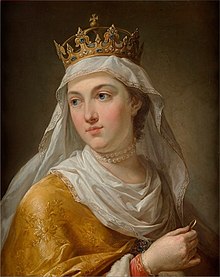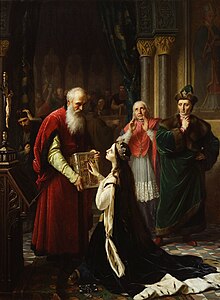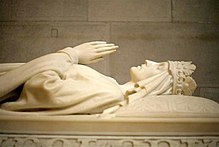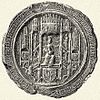| Revision as of 14:45, 25 August 2015 editVolunteer Marek (talk | contribs)Autopatrolled, Extended confirmed users, Pending changes reviewers, Rollbackers94,174 edits restore previous version - please discuss and try to get consensus instead of edit warring← Previous edit | Revision as of 16:02, 25 August 2015 edit undoBorsoka (talk | contribs)Extended confirmed users45,276 edits dubious claimNext edit → | ||
| Line 22: | Line 22: | ||
| }} | }} | ||
| '''Jadwiga''' ({{IPA-pl|jadˈvʲiɡa|}}; 1373/4 – 17 July 1399) was ]<ref name="Barański">''Hedvigis Rex Polonie'': M. Barański, S. Ciara, M. Kunicki-Goldfinger, ''Poczet królów i książąt polskich'', Warszawa 1997, also Teresa Dunin-Wąsowicz, ''''</ref> from 1384 to her death. | '''Jadwiga''' ({{IPA-pl|jadˈvʲiɡa|}}; 1373/4 – 17 July 1399) was ]<ref name="Barański">''Hedvigis Rex Polonie'': M. Barański, S. Ciara, M. Kunicki-Goldfinger, ''Poczet królów i książąt polskich'', Warszawa 1997, also Teresa Dunin-Wąsowicz, ''''</ref> from 1384 to her death. | ||
| She was a member of the ], the daughter of the Polish king ] and ].<ref name="books.google-Davies">{{cite web | url=http://books.google.ca/books?id=b912JnKpYTkC&pg=PA94&dq=%22In+1385%22+%22Jadwiga+arrived+in+Cracow%22&hl=en&sa=X&ei=BiOFT-bRGM_XiQLUs4j2BA&ved=0CDQQ6AEwAA#v=onepage&q=%22In%201385%22%20%22Jadwiga%20arrived%20in%20Cracow%22&f=false | title=Jadwiga (chapter Jogalia) | publisher=Oxford University Press | work=God's Playground: A History of Poland in Two Volumes, Volume 1 | year=2005 | accessdate=10 April 2012 | author=Norman Davies | pages=94–96 | isbn=0-19-925339-0}}</ref> | She was a member of the ], the daughter of the Polish king ] and ].<ref name="books.google-Davies">{{cite web | url=http://books.google.ca/books?id=b912JnKpYTkC&pg=PA94&dq=%22In+1385%22+%22Jadwiga+arrived+in+Cracow%22&hl=en&sa=X&ei=BiOFT-bRGM_XiQLUs4j2BA&ved=0CDQQ6AEwAA#v=onepage&q=%22In%201385%22%20%22Jadwiga%20arrived%20in%20Cracow%22&f=false | title=Jadwiga (chapter Jogalia) | publisher=Oxford University Press | work=God's Playground: A History of Poland in Two Volumes, Volume 1 | year=2005 | accessdate=10 April 2012 | author=Norman Davies | pages=94–96 | isbn=0-19-925339-0}}</ref> | ||
Revision as of 16:02, 25 August 2015
For the 13th-century duchess and saint canonized in 1267, see Hedwig of Silesia.King of Poland
| Jadwiga | |
|---|---|
 Portrait of King Jadwiga by Bacciarelli, painted during 1768-1771 Portrait of King Jadwiga by Bacciarelli, painted during 1768-1771 | |
| King of Poland | |
| Reign | 16 October 1384 – 17 July 1399 |
| Coronation | 16 October 1384 Wawel Cathedral, Kraków |
| Predecessor | Louis |
| Successor | Władysław II Jagiełło |
| Born | Between 3 October 1373 and 18 February 1374 Buda, Kingdom of Hungary |
| Died | 17 July 1399 (age 25) Kraków, Kingdom of Poland |
| Spouse | Władysław II Jagiełło |
| Issue | Elizabeth Bonifacia |
| House | Capetian House of Anjou |
| Father | Louis I of Hungary |
| Mother | Elizabeth of Bosnia |
| Religion | Roman Catholic |
Jadwiga (Template:IPA-pl; 1373/4 – 17 July 1399) was ] from 1384 to her death. She was a member of the Capetian House of Anjou, the daughter of the Polish king Louis and Elizabeth of Bosnia.
Queens regnant being relatively uncommon in Europe at the time, Jadwiga was officially crowned a "king" (rex) rather than "queen" (regina). She is an important link in the transition of the Polish monarchy from the extinguished House of Piast to the Jagiellon dynasty (Lithuanian in origin).
Childhood

Jadwiga was the youngest daughter of Louis I of Hungary and Elizabeth of Bosnia. Jadwiga could claim descent from the House of Piast, as both her grandmothers belonged to the ancient native Polish dynasty.
Jadwiga was brought up at the royal court in Buda and Visegrád, Hungary. In 1378, she was betrothed (sponsalia de futuro) to Habsburg scion William of Austria, and spent about a year at the imperial court in Vienna, Austria. Jadwiga's father Louis had, in 1364 in Kraków, during festivities known as the Days of Kraków, also made an arrangement with his former father-in-law, Holy Roman Emperor Charles IV, to inter-marry their future children: Charles' son and future emperor, Sigismund of Luxemburg, was engaged and married, as a child, to Louis' daughter and future successor Mary. One of Louis' original plans had been to leave the kingdom of Poland to Mary, whose marriage with Sigismund was more relevant to this end as Sigismund was an heir in his own right to Poland and was intended to inherit Brandenburg, which was nearer to Poland than to Hungary. Jadwiga's destiny as wife of an Austrian duke was a better fit for Hungary, as it was an immediate neighbor of Austria.
Jadwiga was well-educated and a polyglot, speaking at least five languages such as Latin, Hungarian, Serbian, Polish and German, interested in the arts, music, science, and court life. She was also known for her piety and her admiration for Saints Mary, Martha, and Bridget of Sweden, as well as her patron saint, Hedwig of Andechs.
Reign
Until 1370, Poland had been ruled by the native Piast Dynasty. Its last king, Casimir III, had left no legitimate son and considered his male grandchildren either unsuited or too young to reign. He therefore decided that the surviving son of his sister Elizabeth, Louis I of Hungary, should succeed him. Louis was proclaimed king, while Elizabeth held much of the practical power until her death in 1380.
When Louis died in 1382, the Hungarian throne was inherited by his eldest surviving daughter Mary, under the regency of their Bosnian mother. In Poland, however, the Szlachtas of Lesser Poland (Poland's virtual rulers) did not want to continue the personal union with Hungary, nor to accept as regent Mary's fiancé Sigismund, whom they expelled from the country. They therefore chose as their new monarch Mary's younger sister, Jadwiga. After two years' negotiations with Jadwiga's mother, Elizabeth of Bosnia, who was regent of Hungary, and a civil war in Greater Poland (1383), Jadwiga finally came to Kraków and at the age of ten, on 16 October 1384 (or 1385, sources vary), was crowned "king" of Poland — Hedvig Rex Poloniæ, not Hedvig Regina Poloniæ, as Polish law had no provision for a female ruler (queen regnant).

As child monarch of Poland, Jadwiga had at least one relative in Poland (all her immediate family having remained in Hungary): her mother's childless uncle, Władysław the White (d. 1388), Prince of Gniewkowo. Soon after Jadwiga's coronation, new suitors for Jadwiga's hand appeared: Duke Siemowit IV of Masovia and Grand Duke Jogaila of Lithuania, the latter supported by the lords of Lesser Poland. In 1385 (when Jadwiga was eleven years old) William of Austria came to Kraków to consummate the marriage and present the lords with a fait accompli. His plan, however, failed and William was expelled from Poland while Jadwiga declared her sponsalia invalid. William later married Jadwiga's cousin, Joan II of Naples. That same year (1385), Jogaila and the lords of Lesser Poland signed the Union of Krewo whereby Jogaila pledged to adopt Western Christianity and unite Lithuania with Poland in exchange for Jadwiga's hand and the Polish crown. Twelve-year-old Jadwiga and 26-year-old Jogaila — who had earlier been baptized Władysław — wed on 18 February 1386 at Kraków. This was followed by Jogaila's coronation as King of Poland, although Jadwiga retained her royal rights.
In 1386, Jadwiga's mother Elizabeth and her sister Queen Mary of Hungary were kidnapped. In January 1387, Elizabeth was strangled, while Mary was released in July of the same year, by the effort of future Frankopan family and Jadwiga's adopted maternal uncle King Tvrtko of Bosnia. Mary, heavily pregnant, died in 1395 under suspicious circumstances.
As a monarch, young Jadwiga probably had little actual power. Nevertheless, she was actively engaged in her kingdom's political, diplomatic and cultural life and acted as the guarantor of Władysław's promises to reclaim Poland's lost territories. In 1387, Jadwiga led two successful military expeditions to reclaim the province of Halych in Red Ruthenia, which had been retained by Hungary in a dynastic dispute at her accession. As she was an heiress to Louis I of Hungary herself, the expeditions were for the most part peaceful and resulted in Petru I of Moldavia paying homage to the Polish monarchs in September 1387. In 1390 she began a correspondence with the Teutonic Knights, followed by personal meetings in which she opened diplomatic negotiations herself.
Most political responsibilities, however, were probably in Władysław's hands, with Jadwiga attending to cultural and charitable activities. She sponsored writers and artists and donated much of her personal wealth, including her royal insignia, to charity, for purposes including the founding of hospitals. She financed a scholarship for twenty Lithuanians to study at Charles University in Prague to help strengthen Christianity in their country, to which purpose she also founded a bishopric in Vilnius. Among her most notable cultural legacies was the restoration of the Kraków Academy, which in 1817 was renamed Jagiellonian University in honour of the couple.
Death and inheritance

On 22 June 1399 Jadwiga gave birth to a daughter, Elizabeth Bonifacia. Within a month, both the girl and her mother had died from birth complications. They were buried together in Wawel Cathedral. Jadwiga's death undermined Jogaila's position as King of Poland, but he managed to retain the throne until his death 35 years later.
It is not easy to determine who was Jadwiga's heir in line of Poland or Poland's rightful heir, because Poland had not used primogeniture and therefore kings had ascended by some sort of election. There were descendants of superseded daughters of Casimir III of Poland (d. 1370), such as his youngest daughter Anna, Countess of Celje (d. 1425 without surviving Issue), and her daughter Anna of Celje (1380–1416) whom Władysław II Jogaila married next. Anna had a daughter Jadvyga of Lithuania born in 1408 (the name Jadvyga (Jotvinga) originates from Lithuanian speaking people name Jotvingiai (they called themselves by ethnonime Dainaviai, i.e. singing people) who lived under Kiev Rus command in nowadays Belarus, Ukraine and Poland and who were called Yatviagi by orthodox Slavic sources in Slavic language). Jadvyga died in 1431, reputedly poisoned by Sophia, Władysław's last wife, after a faction of Polish nobles supported Jadvyga against Sophia's sons. Emperor Sigismund himself was an heir of Grand Duke of Lithuania Gediminas and Casimir III, as eldest son of his mother Elisabeth of Pomerania, who was since 1377 the only surviving child of Elisabeth of Poland, herself daughter of Casimir III from his first marriage with Aldona Gediminaite of Lithuania. The family possession of the principality of Kuyavia belonged to Sigismund, who was the heir with the strongest hereditary claims. However, the leaders of the country wanted to avoid Sigismund and any personal union with Hungary.
Other descendants of Władysław the Short (through the Silesian dukes of Świdnica) included the then Emperor Wenceslas, King of Bohemia, who died without issue in 1419, as well as the Silesian dukes of Opole and Sagan. Male line Piasts were represented most closely by the Dukes of Masovia, one of whom had aspired to marry Jadwiga in 1385. Also various princes of Silesia were of Piast descent, but they had been largely pushed aside since the exile of Vladislas II, Duke of Kraków.
Jadwiga's husband Władysław II Jagiełło (Jogaila) retained the throne primarily because no claimant of greater eminence appeared. He was never ousted, even after the death of his second wife, and eventually succeeded to found a dynasty in Poland by the sons of his last wife, who were not related to earlier Polish rulers.
Legends and veneration
| Jadwiga of Poland | |
|---|---|
| King of Poland | |
| Venerated in | Roman Catholic Church |
| Beatified | 8 August 1986, Kraków, Poland |
| Canonized | 8 June 1997, Kraków, Poland |
| Major shrine | Wawel Cathedral, Kraków, Poland |
| Feast | 8 June |
| Attributes | Royal dress and shoes, apron full of roses |
| Patronage | Queens, united Europe |
From the time of her death, Jadwiga was venerated widely in Poland as a saint. Numerous legends about miracles were recounted to justify her sainthood. The two best-known are those of "Jadwiga's cross" and "Jadwiga's foot":
Jadwiga often prayed before a large black crucifix hanging in the north aisle of Wawel Cathedral. During one of these prayers, the Christ on the cross is said to have spoken to her. The crucifix, "Saint Jadwiga's cross," is still there, with her relics beneath it. Because of this event, she is considered a medieval mystic.
According to another legend, Jadwiga took a piece of jewelry from her foot and gave it to a poor stonemason who had begged for her help. When the king left, he noticed her footprint in the plaster floor of his workplace, even though the plaster had already hardened before her visit. The supposed footprint, known as "Jadwiga's foot", can still be seen in one of Kraków's churches.
In yet another legend, Jadwiga was taking part in a Corpus Christi Day procession when a coppersmith's son drowned by falling into a river. Jadwiga threw her mantle over the boy's body, and he regained life.
On 8 June 1979 Pope John Paul II prayed at her sarcophagus; and the Congregation for Divine Worship and the Discipline of the Sacraments officially affirmed her beatification on 8 August 1986. The Pope went on to canonize Jadwiga in Kraków on 8 June 1997.
Exhumations and sarcophagus

Jadwiga's body has been exhumed at least three times. The first time was in the 17th century, in connection with the construction of a bishop's sarcophagus next to Jadwiga's grave. The next exhumation took place in 1887. Jadwiga's complete skeleton was found, together with a mantle and hat. Jan Matejko made a sketch of Jadwiga's skull, which later helped him paint her portrait (see below).
On 12 July 1949, her grave was again opened. This time she was reburied in a sarcophagus paid for by Karol Lanckoroński, which had been sculpted in white marble in 1902 by Antoni Madeyski. The female king is depicted with a dog, a symbol of fidelity, at her feet. The sarcophagus is oriented with Jadwiga's feet pointing west, unlike all the other sarcophagi in the cathedral. On display next to the sarcophagus are the modest wooden orb and scepter with which the she had been buried – she had sold her jewels to finance the renovation of the Kraków Academy, known today as Jagiellonian University.
Ancestors
Gallery
-
 The restoration of the Kraków Academy by Queen Jadwiga.
The restoration of the Kraków Academy by Queen Jadwiga.
-
 Portrait by Jan Matejko
Portrait by Jan Matejko
-
 Psalms of Queen Jadwiga in three languages (Latin, Polish and German).
Psalms of Queen Jadwiga in three languages (Latin, Polish and German).
-
 Queen Jadwiga's Cup from the Wawel Cathedral.
Queen Jadwiga's Cup from the Wawel Cathedral.
-
 Seal of the Jadwiga of Poland
Seal of the Jadwiga of Poland
-
Jadwiga and Jagiełło (Jogaila) Monument in Kraków Planty Park.
See also
- History of Poland (966–1385)
- History of Poland (1385–1569)
- Armorial of the House Anjou-Sicily Template:Fr icon
- List of Catholic saints
References
- Sroka, S. A. Genealogia Andegawenów, Kraków
- ^ Hedvigis Rex Polonie: M. Barański, S. Ciara, M. Kunicki-Goldfinger, Poczet królów i książąt polskich, Warszawa 1997, also Teresa Dunin-Wąsowicz, Dwie Jadwigi (The Two Hedwigs) Cite error: The named reference "Barański" was defined multiple times with different content (see the help page).
- ^ Norman Davies (2005). "Jadwiga (chapter Jogalia)". God's Playground: A History of Poland in Two Volumes, Volume 1. Oxford University Press. pp. 94–96. ISBN 0-19-925339-0. Retrieved 10 April 2012.
- Crown of Queen Jadwiga, at Talisman World Coins and Medals Accessed 31 March 2011
- ^ Paweł Jasienica (1988). "Władysław Jagiełło". Polska Jagiellonów (in Polish). Warsaw: Państwowy Instytut Wydawniczy. pp. 80–146. ISBN 83-06-01796-X
- Stanisław Waltos (2004). "The Past and the Present". Jagiellonian University's web page. Jagiellonian University. Archived from the original on 19 August 2006. Retrieved 4 August 2006.
- ^ http://www.poczet.com/jadwiga.htm
- "Pawel Jasienica, Jagiellonian Poland (American Institute of Polish Culture: Miami, 1988)."
- Catholic World Culture Chapter XXIII, pp. 146–151
- Psałterz floriański
Further reading
- Heinze, Karl (8 December 2003). Baltic Sagas. Virtualbookworm Publishing. ISBN 1-58939-498-4.
- Kellogg, Charlotte (1931). Jadwiga, Poland's Great Queen. The Macmillan Company.
- Lukowski, Jerzy; Hubert Zawadzki (20 September 2001). A Concise History of Poland. Cambridge University Press. ISBN 0-521-55917-0.
- Turnbull, Stephen; Richard Hook (30 May 2003). Tannenberg 1410. Osprey Publishing. ISBN 1-84176-561-9.
External links
| Jadwiga of Poland AngevinBorn: 1373/4 Died: 17 July 1399 | ||
| Regnal titles | ||
|---|---|---|
| VacantTitle last held byLouis | King of Poland 1384–1399 |
Succeeded byVladislaus II |
| Monarchs of Poland | |
|---|---|
| Legendary | |
| Proto-historic (before 966) | |
| Piast dynasty (966–1138) | |
| Fragmentation period (1138–1320) | Senior or Supreme Princes
|
| Přemyslid dynasty (1296–1306) |
|
| Restored Piast dynasty (1320–1370) | |
| Capet-Anjou dynasty (1370-1399) | |
| Jagiellonian dynasty (1386–1572) | |
| Elective monarchy (1572–1795) | |
| Duchy of Warsaw (1807–1815) | Frederick Augustus I |
| Romanov dynasty (1815–1917) | |
| |
- Use dmy dates from July 2013
- 1374 births
- 1399 deaths
- 14th-century Christian saints
- 14th-century female rulers
- 14th-century Hungarian people
- 14th-century Polish people
- Beatifications by Pope John Paul II
- Burials at Wawel Cathedral
- Canonizations by Pope John Paul II
- Christian female saints of the Middle Ages
- Deaths in childbirth
- Grand Duchesses of Lithuania
- House of Anjou-Hungary
- House of Jagiellon
- Hungarian princesses
- Jagiellonian University
- Medieval child rulers
- Medieval Polish saints
- People of Byzantine descent
- Polish monarchs
- Polish princesses
- Polish Roman Catholic saints
- Polish women in politics
- Roman Catholic monarchs
- Roman Catholic royal saints
- Women who have been crowned king